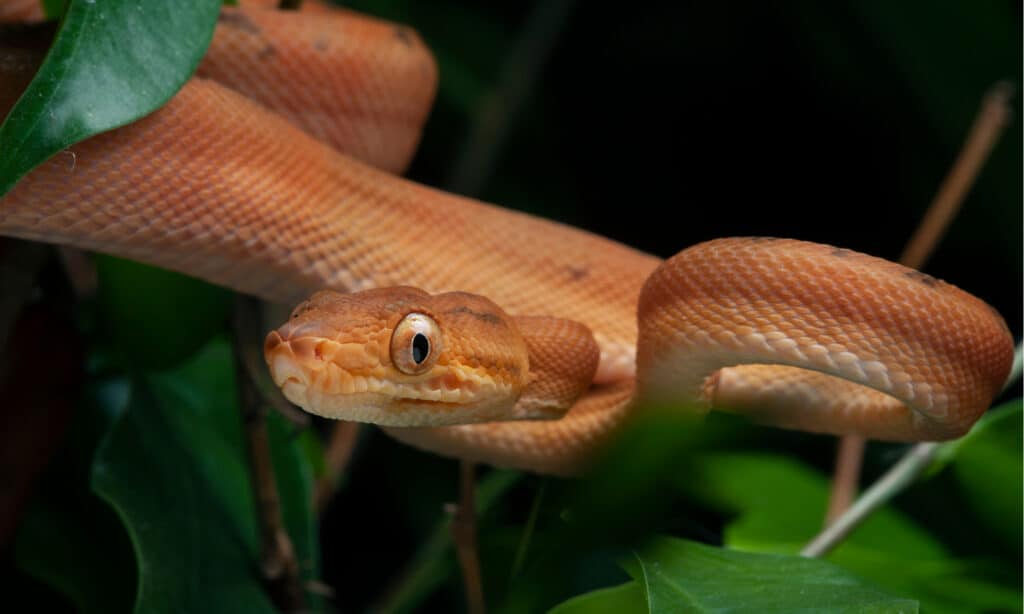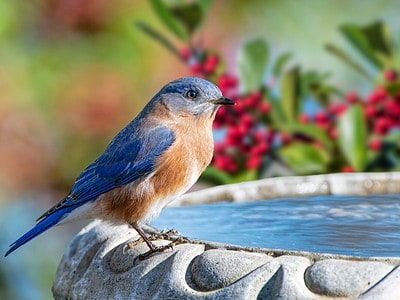Amazon Tree Boa
Corallus hortulanus
Amazon tree boas come in a rainbow of colors.
Advertisement
Amazon Tree Boa Scientific Classification
- Kingdom
- Animalia
- Phylum
- Chordata
- Class
- Reptilia
- Order
- Squamata
- Family
- Pythonidae
- Genus
- Corallus
- Scientific Name
- Corallus hortulanus
Read our Complete Guide to Classification of Animals.
Amazon Tree Boa Conservation Status
Amazon Tree Boa Facts
- Prey
- mice, rats, lizards, frogs, bats, birds
- Main Prey
- Lizards and frogs
- Name Of Young
- neonates
- Group Behavior
- Solitary
- Solitary except during mating season
- Fun Fact
- Amazon tree boas come in a rainbow of colors.
- Biggest Threat
- Habitat destruction
- Most Distinctive Feature
- Large eyes and slender body
- Other Name(s)
- Boa amazónica de jardín, boa arborícola amazónica, boa de los jardines, boa arborícola del amazonas, macabrel
- Gestation Period
- 4-5 months
- Average Litter Size
- 4-9
- Lifestyle
- Nocturnal
- Diurnal
- Favorite Food
- Birds, bats, rodents, lizards, frogs
- Common Name
- Garden tree boa
- Special Features
- Large eyes and slender body.
- Location
- Amazon forests
View all of the Amazon Tree Boa images!
Amazon tree boas are widely kept as pets, but surprisingly little is known about them in the wild.
This slender boa naturally comes in several colors, called phases. It’s a nonvenomous cousin to the emerald tree boa (Corallus caninus). Both are popular pets among experienced herpetoculturists and prized jewels of some zoo collections.
Incredible Amazon Tree Boa Facts
- Amazon tree boas spend most of their lives in trees and only rarely come to the ground, but sometimes find a quiet corner on the ground to rest.
- They are still very common in the wild but very difficult to find when you go looking for them.
- These snakes have two genetically inherited phases, the garden phase and the colored phase.
Scientific Name and Classification of the Amazon Tree Boa
The Amazon tree boa is a member of the Boidae family of nonvenomous constrictors. Its scientific name is Corallus hortulana; although some sources list it as Corallus hortulanus. Corallus genus boas are native to Central America, South America, and the West Indies. Its specific name, hortulana, refers to the gardens where many residents can see these snakes.
This species goes by a few common names. In addition to the Amazon tree boa, it’s also called the garden boa, garden tree boa, boa Amazónica de jardín, boa arborícola Amazónica, boa de los jardines, boa arborícola del amazonas, and the macabrel.
Amazon Tree Boa Appearance
Amazon tree boas are long and thin, unlike some of their bulky boa cousins. These snakes range between five and six and a half feet in length and, even in nature, exhibit a wide variety of colors and patterns. Their base color can be black, brown, gray, red, orange, or yellow with speckles, bands, saddles, chevrons, or rhomboid shapes – or have no pattern at all. Color patterns are grouped into “phases,” the garden phase is drab with highly variable patterning, while the vivid reds, oranges, and yellows are another group called the color phase. Some of the color phase boas have patterns, and others do not.
Unlike the green tree python and emerald tree boa, Amazon tree boas don’t change colors as they mature. Aside from their patterns, which develop as they grow, they’re born with the color they’ll be as adults.
This species has large eyes with elliptical pupils that often match their body color. Amazon tree boas have excellent eyesight that they use during the day. Their heat-sensing pits are located along the upper and lower lip, and they use them at night to locate their prey. Their long, needle-like teeth and strong jaws make a bite painful, but they’re not venomous. So, the most you’ll have is a tooth left behind and possibly an infection if you don’t keep the area clean.
Amazon Tree Boa Behavior
This species lives the majority of its life in the trees, although they sometimes coil up in a safe hideout on the ground. The Amazon tree boa is solitary and can be active during the day and the night. However, they are more active at dusk and earlier in the night when the temperatures are a little cooler, and their prey is just getting moving.
Some keepers report that the individuals they have aren’t prone to biting. However, that isn’t the norm. These snakes are not shy about using their long, sharp teeth, even though they aren’t as long as those of the emerald tree boa (Corallus caninus) they’re still formidable. Amazon tree boas are known for their aggression, and it’s a rare snake that doesn’t lash out at a handler. When they strike, it is usually at the face.
However aggressive they are, it’s their adaptability that helps them adjust to captivity. This tendency to strike at everything is why most people try to keep these snakes in enclosures that are out of main traffic areas. Some keepers say that handling these snakes at night increases your odds of being bitten because they’re mostly nocturnal, so handling them during the day is better.
Many of the snakes in collections around the world are imported. More breeders are selling captive-bred individuals, but the vast majority are still wild-caught. The aggression and reactivity that this species exhibits may become lessened as more captive-bred individuals are introduced into the pet trade, but that’s unknown as yet. Regardless, this is not the snake for a beginner – try a ball python or a rosy boa; they’re much better choices.

Amazon tree boas have several naturally-occurring colors – including red.
©Amazon Tree Boa/Shutterstock.com
Amazon Tree Boa Habitat and Diet
Of all the Amazonian snakes, this snake has one of the most varied ecological niches. These snakes can be found in many areas of the Amazon, which include Bolivia, Brazil, Colombia, Ecuador, Guyana, Peru, Surinam, and Venezuela. Primarily arboreal, they’re found draped across tree branches in wild forests as well as fruit tree plantations. They are equally comfortable in someone’s garden trees as they are in wild, isolated forests. These snakes are highly adaptable and range from sea level upwards to 3,000 meters in altitude.
Its diet includes rats, mice, bats, lizards, frogs, and birds. Amazon tree boas use their prehensile tales to hang from branches while they wait for prey to come close enough. Watching them feed is interesting all by itself. They can grab their meal, coil around and constrict, and eat it all without ever leaving their perch.
Amazon Tree Boa Predators, Threats, Population, and Conservation
According to the IUCN assessment from 2013, there may be some localized threats such as habitat loss and persecution (it looks like a viper). However, there aren’t any widespread threats. They require trees in order to live, though, so complete deforestation would decimate them. Amazon tree boas are widespread and common throughout their range, but it’s also possible that over-harvesting for the pet trade may affect the species.
These snakes fall prey to other carnivores; birds of prey and other larger animals will eat them if given a chance.
Amazon Tree Boa Reproduction, Babies, and Lifespan
Amazon tree boas can live for over 15 years, and this species becomes sexually mature between the ages of two and five. Males are generally younger when they mature, as the females need to gain a little more size to be able to support the babies until they’re born.
Mating is usually between December and March. These snakes, like other boas, do not lay eggs. The female carries the babies for seven to ten months until they are ready to be born. Usually, a female gives birth to 4-10 neonates between September and November. After their first shed, the babies will take their first meal.
Next Up
Boas are part of a huge family of animals, all nonvenomous. Some can be dangerous to people and livestock, but most aren’t.
- Rainbow boas are named for the rainbow iridescence that appears in the sunlight.
- Green anacondas are the heaviest snakes in the world – and are in the Boidae family.
- Cuban boas can reach 21 feet long, but most only reach 12-15 feet.
Amazon Tree Boa FAQs (Frequently Asked Questions)
Where do Amazon tree boas live?
These snakes live in the Amazon, in the forests and fruit tree plantations of Bolivia, Brazil, Colombia, Ecuador, Guyana, Peru, Surinam, and Venezuela.
How do Amazon tree boas hunt?
These snakes hang from trees and stretch themselves out to look like a tree branch. They wait like this for their prey to wander too close.
Are Amazon tree boas aggressive?
Yes, it seems like most of the Corallus genus has a higher than usual aggression level when you’re talking about boas. It may be because they have to be quick enough to grab quick-moving meals in the trees.
Do Amazon tree boas make good pets?
In the right hands, yes. However, they’re not for beginners and have very specific needs that must be met. And that’s when you’re not dodging their teeth.
Thank you for reading! Have some feedback for us? Contact the AZ Animals editorial team.
Sources
- Corallus info / Accessed July 26, 2022
- Garden Tree Boa | IUCN Redlist of Threatened Species / Published October 25, 2013 / Accessed July 26, 2022
- West Indian Boas / Accessed July 26, 2022
- Corallus hortulana | Reptile Database / Accessed July 26, 2022


















